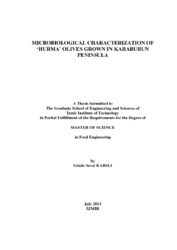Please use this identifier to cite or link to this item:
https://hdl.handle.net/11147/3602Full metadata record
| DC Field | Value | Language |
|---|---|---|
| dc.contributor.advisor | Baysal, Ayşe Handan | - |
| dc.contributor.author | Karslı, Gözde Seval | - |
| dc.date.accessioned | 2014-07-22T13:51:55Z | - |
| dc.date.available | 2014-07-22T13:51:55Z | - |
| dc.date.issued | 2013 | - |
| dc.identifier.uri | http://hdl.handle.net/11147/3602 | - |
| dc.description | Thesis(Master)--Izmir Institute of Technology, Food Engineering, Izmir, 2013 | en_US |
| dc.description | Includes bibliographical references (leaves: 83-88) | en_US |
| dc.description | Text in English; Abstract: Turkish and English | en_US |
| dc.description | xi, 96 leaves | en_US |
| dc.description | Full text release delayed at author's request until 2015.08.03 | en_US |
| dc.description.abstract | Erkence variety olive (Olea europea L.) cultivar growing in the Aegean Region of Turkey is a naturally black olive. Debittered Erkence variety called "Hurma" olive is an unusual olive type which is characterized by the sweet taste of its fruit. This olive which is grown mainly in Karaburun Peninsula differs from other varieties since it ripens on the tree losing its bitterness caused by phenolic compounds especially oleuropein. Thus, Hurma olives can be directly consumed from the tree without a further debittering process to make them edible. Total aerobic mesophilic microorganisms, lactic acid bacteria (LAB), Enterobacteriacaae, Pseudomonadaceae, Staphylococcaceae-Micrococcaceae, moulds and yeasts were enumerated in the olive drupes, leaves and orchards' air of Erkence and Gemlik cultivars during the maturation period. Moreover, bacterial microflora of Hurma olive fruit, leaf and orchards' air were characterized in terms of DNA sequencing. Microbial loads of naturally debittered "Hurma" olive were higher when compared with Gemlik olive's and non-debittered Erkence variety olive's. But no Pseudomonadaceae, Staphylococcaceae-Micrococcaceae and LAB were detected in all samples. Bacterial microflora genera of Hurma olive comprised of Bacillus, Pantoea, Acinetobacter and Pseudomonas while the other samples have also similar bacterial genera. The common genus found in all samples was Bacillus. Besides, more diversified genera were obtained from phylloplane and air microflora of Erkence variety olive orchard was substantially similar to bacterial phylloplane of leaf. This is the first study about microbiological characterization of Hurma olive type and will lead up to new studies about it. | en_US |
| dc.language.iso | en | en_US |
| dc.publisher | Izmir Institute of Technology | en_US |
| dc.rights | info:eu-repo/semantics/openAccess | en_US |
| dc.subject | Karaburun Peninsula | en_US |
| dc.subject.lcsh | Olive--Analysis | en |
| dc.subject.lcsh | Food--Microbiology | en |
| dc.title | Microbiological Characterization of 'hurma Olives Grown in Karaburun Peninsula | en_US |
| dc.type | Master Thesis | en_US |
| dc.institutionauthor | Karslı, Gözde Seval | - |
| dc.department | Thesis (Master)--İzmir Institute of Technology, Food Engineering | en_US |
| dc.relation.publicationcategory | Tez | en_US |
| dc.identifier.wosquality | N/A | - |
| dc.identifier.scopusquality | N/A | - |
| item.openairetype | Master Thesis | - |
| item.grantfulltext | open | - |
| item.cerifentitytype | Publications | - |
| item.languageiso639-1 | en | - |
| item.fulltext | With Fulltext | - |
| item.openairecristype | http://purl.org/coar/resource_type/c_18cf | - |
| Appears in Collections: | Master Degree / Yüksek Lisans Tezleri | |
Files in This Item:
| File | Description | Size | Format | |
|---|---|---|---|---|
| 10011520.pdf | MasterThesis | 2.37 MB | Adobe PDF |  View/Open |
CORE Recommender
Page view(s)
11,384
checked on Feb 3, 2025
Download(s)
204
checked on Feb 3, 2025
Google ScholarTM
Check
Items in GCRIS Repository are protected by copyright, with all rights reserved, unless otherwise indicated.